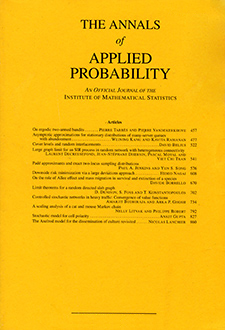Abstract
Under the continuous assumption on the generator g, Briand et al. [Electron. Comm. Probab. 5 (2000) 101–117] showed some connections between g and the conditional g-expectation $({\mathcal{E}}_{g}[\cdot|{\mathcal{F}}_{t}])_{t\in[0,T]}$ and Rosazza Gianin [Insurance: Math. Econ. 39 (2006) 19–34] showed some connections between g and the corresponding dynamic risk measure (ρtg)t∈[0, T]. In this paper we prove that, without the additional continuous assumption on g, a g-expectation ${\mathcal{E}}_{g}$ satisfies translation invariance if and only if g is independent of y, and ${\mathcal{E}}_{g}$ satisfies convexity (resp. subadditivity) if and only if g is independent of y and g is convex (resp. subadditive) with respect to z. By these conclusions we deduce that the static risk measure ρg induced by a g-expectation ${\mathcal{E}}_{g}$ is a convex (resp. coherent) risk measure if and only if g is independent of y and g is convex (resp. sublinear) with respect to z. Our results extend the results in Briand et al. [Electron. Comm. Probab. 5 (2000) 101–117] and Rosazza Gianin [Insurance: Math. Econ. 39 (2006) 19–34] on these subjects.
Citation
Long Jiang. "Convexity, translation invariance and subadditivity for g-expectations and related risk measures." Ann. Appl. Probab. 18 (1) 245 - 258, February 2008. https://doi.org/10.1214/105051607000000294
Information





